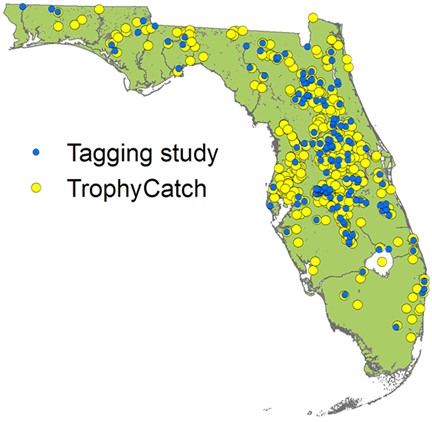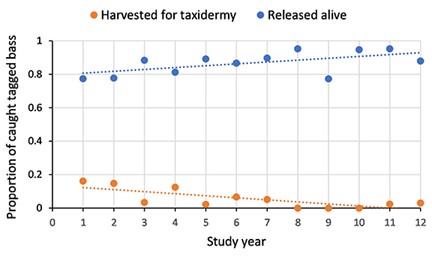
by Florida Fish & Wildlife Conservation Commission TrophyCatch staff
Ever caught a tagged bass? Whether you’re an avid tournament angler, a regular weekend warrior or just an occasional bass fishing participant, you could be next, and your participation is important. All anglers in Florida should be on the lookout for tagged bass and the opportunity to participate in an important fishery monitoring project.
The practice of tagging fish for anglers to later catch is a mainstay in the fisheries biologists’ toolbox that helps them measure critical factors of a fishery. The process begins with tagging fish and releasing them back into the wild. Through time, as more tagged fish are caught and reported by anglers, biologists can estimate the proportion of the overall population that is caught or harvested each year.
Florida Fish and Wildlife Conservation Commission’s (FWC) Trophy Bass Tagging Study provides information through tagging studies and works in tandem with the TrophyCatch program.
TrophyCatch was launched in 2012, but the tagging study actually began one year prior. Since then, FWC biologists have used the study to continuously monitor catch, harvest and release rates of trophy bass. Tracking these rates through time is important because a core goal of TrophyCatch has been to encourage anglers to release their trophy bass alive and healthy — which is required of all bass submitted to the program.
Since 2011, FWC biologists have tagged 1,722 trophy bass that weighed 8 pounds or heavier. Those bass were sampled from across 165 public waterbodies in Florida. Each year, between 29-56 individual waterbodies had at least one or more trophy bass tagged and released by biologists.
Anglers have caught and reported 425 (25%) of all bass tagged in the study. Most tagged bass were caught on artificial lures (about 80%), and tagged bass were caught in tournaments 15% of the time.
Based on tag returns, yearly estimates of catch rates for trophy bass have varied between 12% and 27% of the state’s trophy bass population, with an overall average of 18%. This suggests — about one out of every five trophy bass living in Florida’s public waters is caught each year.

The number of tagged bass kept by anglers each year has been quite small. The estimated percentage of Florida’s trophy bass population harvested each year has ranged from a very, very low 1% to 6%. This is due to a high percentage (77%–95%) of all tagged trophy bass caught each year being released alive. Across the 12 years of the study, release rates show an increasing trend. So, while harvest of trophy bass was low at the outset of this study, it has gotten even lower.
Coincident with the trend of increasing release rate, the study has shown significant reduction in harvest of trophy bass in Florida for traditional skin-mount taxidermy.

The TrophyCatch requirement for live release of submitted bass as well as providing discounted replica mount pricing to anglers in the Lunker and Trophy Club, and free replicas to anglers in the Hall of Fame Club, is in line with current trends in Florida’s trophy bass fishery. The patterns in harvest and release underscore that anglers in Florida increasingly value the live release of their catch.
The Trophy Bass Tagging Study has shown that both awareness of and participation (submission of a qualifying bass) in TrophyCatch has grown over the years. During the last two years, awareness of the program among anglers who caught a tagged trophy bass reached 80%. Similarly, the participation rate climbed to nearly 40%. These spikes in awareness and participation followed the launch of the TrophyCatch 10-Tag Challenge (also known as the Pink Tag Challenge), which was hugely popular with anglers and likely responsible for the boost.
While awareness and participation of TrophyCatch have tracked well with one another over the years, participation still consistently lags behind awareness. In other words, many anglers are aware of the program, but due to a variety of reasons, they do not enter their eligible bass in TrophyCatch.
To help close that gap, our number one recommendation to anglers is to be prepared and plan ahead. One of the best ways to do so is to register with the TrophyCatch program and become familiar with the guidelines for participation. Double check batteries in your scale and practice that “scale-to-tail” photo so you are ready when that big bass strikes! Even if you don’t think you are likely to catch a trophy bass, being counted when you register also shows your support for Florida bass conservation and to potential TrophyCatch partners and supporters. Registration also enters you into the annual free boat drawing!
What to do if you catch a tagged bass
Keep an eye out for any tagged bass! Tags used by FWC are printed with an identification code, a telephone number and a reward value. Tags will be located next to the dorsal fin and protrude about three inches. Most tags are yellow and easily seen but sometimes will become coated in a thin layer of algae that makes them a bit less obvious, so double check that bass for a tag. If you catch a tagged bass, please clip it off and call the number on the tag!




